6 results
Statistics task cards on sale
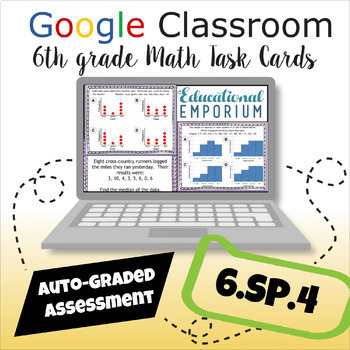
6.SP.4 Math Task Cards SELF-GRADING 6th Grade ★ Displaying Numerical Data
Plotting Data on Number Lines, Including Dot Plots, Histograms, and Box Plots Task Cards for 6th Grade Math Centers: These 12 digital task cards (2 sets of 6) are aligned with Common Core Standards 6.SP.4: Displaying Numerical Data in Plots on a Number Line, Including Dot Plots, Histograms, and Box Plots. Designed to make the classroom efficient and interactive, these task cards are presented as a self-grading Google Form that automatically generates a spreadsheet of student scores, making gradi
Grades:
5th - 7th
Types:
CCSS:

6.SP.1 Task Cards 6th Grade Math AUTO-GRADED Google Form ★ Statistical Questions
Asking Statistical Questions Task Cards for 6th Grade Math Centers: These 12 digital task cards (2 sets of 6) are aligned with Common Core Standard 6.SP.1: Recognize a Statistical Question as One that Anticipates Variability in the Data Related to the Question and Accounts for it in the Answers. Designed to make the classroom efficient and interactive, these task cards are presented as a self-grading Google Form that automatically generates a spreadsheet of student scores, making grading papers
Grades:
5th - 7th
Types:
CCSS:
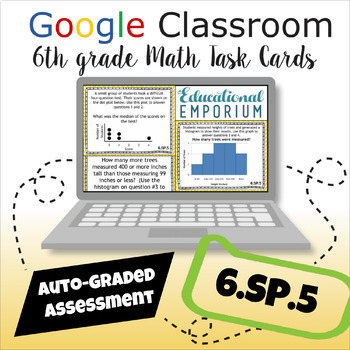
6.SP.5 Math Task Cards 6th Grade Google Forms ★ Summarize Numerical Data Sets
Summarizing a Numerical Data Set According to its Context Task Cards for 6th Grade Math Centers: These 12 digital task cards (2 sets of 6) are aligned with Common Core Standards 6.SP.5: Summarize Numerical Data Sets in Relation to their Context. Designed to make the classroom efficient and interactive, these task cards are presented as a self-grading Google Form that automatically generates a spreadsheet of student scores, making grading papers a thing of the past. Simply copy and paste the valu
Grades:
5th - 7th
Types:
CCSS:
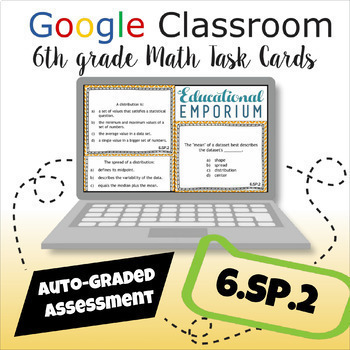
6.SP.2 Math Task Cards 6th Grade Google ★ Center, Spread & Shape of Distribution
Describing a Distribution by its Center, Spread, and Shape Task Cards for 6th Grade Math Centers: These 12 digital task cards (2 sets of 6) are aligned with Common Core Standards 6.SP.2: Center, Spread, and Shape of Distributions. Designed to make the classroom efficient and interactive, these task cards are presented as a self-grading Google Form that automatically generates a spreadsheet of student scores, making grading papers a thing of the past. Simply copy and paste the values into your gr
Grades:
5th - 7th
Types:
CCSS:
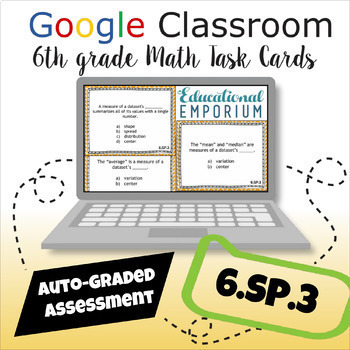
6.SP.3 Task Cards 6th Grade Math AUTO-GRADED Google Form ★ Center and Variation
Understanding the Difference between Center and Variation Task Cards for 6th Grade Math Centers: These 12 digital task cards (2 sets of 6) are aligned with Common Core Standards 6.SP.3: Center and Variation. Designed to make the classroom efficient and interactive, these task cards are presented as a self-grading Google Form that automatically generates a spreadsheet of student scores, making grading papers a thing of the past. Simply copy and paste the values into your gradebook (or link your G
Grades:
5th - 7th
Types:
CCSS:
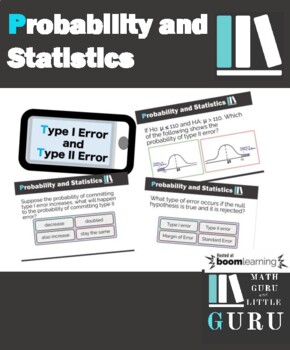
Boom Cards Statistics Type I and Type II Error Digital Task Cards
Grab this 15 Digital Task Card Statistics Type I and Type II Error Boom Cards! This will nurture your student's knowledge in understanding of Type I and Type II Error! A must have in your math class!Probability and Statistics Boom Cards!Type I Error and Type II ErrorThis deck of cards is a multiple choice type quiz review which let your students master and understand the probabilities of committing type I and type II error before moving to calculating Type I and Type II error. When does type I e
Subjects:
Grades:
10th - 12th, Higher Education, Adult Education
Types:
Showing 1-6 of 6 results





